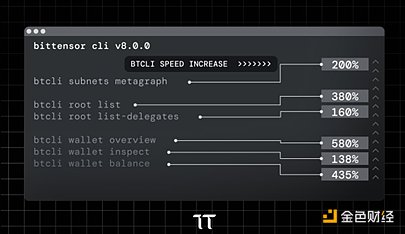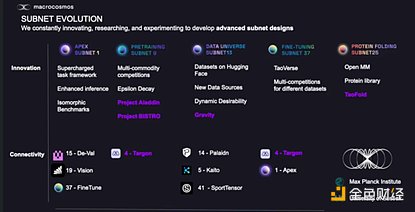Author: Revc, Jinse Finance
Preface
Since the Fed started the interest rate cut cycle, the market value of crypto assets has increased by more than 300 billion US dollars. In the past week, MEME, AI and public chain sectors have rotated, and Bittensor (TAO) has led the AI and public chain sectors with an explosive performance of nearly 66% increase in seven days, and the coin price has reached an 18-month high. Projects with strong narrative and broad application prospects are more likely to be favored by capital and users. Below we analyze the logic of Bittensor's outbreak and find the investment rhythm of this cycle.

Exploring the factors behind Bittensor’s outstanding performance
Bittensor's rise over the past week is attributed to a combination of technological advancement, strategic partnership development, community sentiment, and broad market dynamics that favor projects at the intersection of AI and blockchain, as AI has been the theme of the capital market over the past year . The specific reasons for Bittensor's rise are as follows:
Technology upgrade and innovation:
Bittensor announced the release of Bittensor v8.0.0, which introduces significant performance enhancements through the new BTCLI and Bittensor SDK . BTCLI is a tool used to interact with the Bittensor network. The code has been rewritten to make the interaction more efficient. The Bittensor SDK separates auxiliary functions and becomes lighter and easier to deploy. This upgrade not only improves the user experience and interaction with the network, but may also attract more developers, users and investors.

Advances in AI training:
Bittensor ’s announcement about decentralized large language model (LLM) training, as well as mentions of network and EVM compatibility, shows that AI training methods are continuing to innovate, sparking interest and investment in TAO.
Strategic Cooperation:
Bittensor disclosed its collaboration with entities such as @MacrocosmosAI, @manifoldlabs, and @const_reborn for distributed training, indicating that Bittensor is expanding its ecosystem through partnerships. Collaborations can enhance Bittensor's capabilities, attract more users, and validate its technology to a wider audience, which will have a positive impact on its market perception.
Increased practicality and real-world application:
The practicality of distributed AI training is increasing. As Bittensor’s technology is used more in real-world applications, its intrinsic value is likely to increase .

Network Growth and Influence:
As more participants join, the value of each node increases, and the concept of a “ network effect ” may materialize. This growth can create a positive feedback loop, where increased participation increases value, which in turn attracts more participants.
About Bittensor
Bittensor is an open source protocol designed to support a decentralized machine learning network based on blockchain. In this network, machine learning models can be trained collaboratively and rewarded with TAO tokens based on the value of the information they provide to the collective. TAO not only provides users with access to the network, but also allows users to adjust their activities according to their needs.
Bittensor promotes a new AI development and distribution strategy by leveraging blockchain technology, emphasizing open access, decentralized governance, and the use of global computing power and innovation resources within an incentive framework. As an open source machine intelligence repository, Bittensor provides equal access to users around the world, promoting open, permissionless innovation. The distribution of rewards and network ownership is based on the value of user contributions.
The core of Bittensor is to build a decentralized network to change the way artificial intelligence is developed, shared and monetized. Through the peer-to-peer smart market, miners can contribute to the training of machine learning models and receive corresponding token rewards. The platform's native cryptocurrency TAO adopts a fixed total supply design to incentivize users to participate in the construction of the network.
Bittensor 's architecture includes subnets , Subtensor , and Bittensor API . Subnets are incentive-based competitive markets that focus on different AI tasks and can compete and collaborate with each other; Subtensor is the core blockchain that records transactions and model contributions to ensure network transparency and security; Bittensor API connects the two and coordinates the operation of the entire network.
The incentive mechanism is the key to Bittensor. Each subnet has unique rules, and participants are divided into subnet miners, validators, and nominators. Miners solve tasks, validators evaluate the work of miners, and nominators stake TAO and receive rewards based on the performance of validators. Rewards are distributed through the Yuma consensus mechanism. There is a competition and elimination mechanism between subnets to ensure the continuous optimization and efficient operation of the network.
Bittensor allows machine learning models to be trained in a distributed network, forming a collaborative environment and ensuring that network contributors are compensated accordingly. Bittensor ensures the integrity of its network through multiple security measures. The token-based incentive mechanism encourages miners to contribute value and decentralizes control to prevent a single entity from dominating the platform . In addition, the platform implements anti-cheating protocols and optional hotkey security features to maintain a fair and transparent ecosystem and protect users' data and transaction privacy.
Conclusion
The value of Bittensor depends on whether it can establish a decentralized advantage in the competition with centralized projects such as OpenAI. The short-term value depends on whether the AI computing power model of each subnet can be directly combined with commercial scenarios, otherwise it is just a hyped AI bubble. The long-term value depends on the verification of AI calculation results, the evaluation of the effective workload of the model, and whether the task distribution system and miner rewards can get rid of the dependence on Web2 projects.
In the Web2 market, the valuation of most AI projects is estimated by converting revenue into annuity, especially when they have been commercially operated for a period of time, the valuation system is relatively mature, and product revenue can be audited and confirmed because it is market-oriented. However, Bittensor has a major problem, that is, the total upper limit of token incentives has been determined, but the value of miners' contributions is not evaluated by income and scenarios. Token rewards are only distributed at the highest computing power level that can be achieved within its own system, resulting in a disconnect with the market. Therefore, commercialization as soon as possible instead of relying solely on network incentives can ensure the long-term development of the project. At present, TAO's daily trading volume has decreased by 35%, and investors need to pay attention to related risks.







